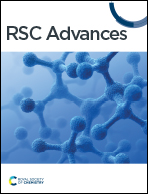Improving thermoelectric performance by constructing a SnTe/ZnO core–shell structure†
Abstract
SnTe is becoming a new research focus as an intermediate temperature thermoelectric material for its environment-friendly property. Herein, the SnTe/ZnO core–shell structure prepared by a facile hydrothermal method is firstly constructed to enhance the thermoelectric performance. The characterization results demonstrate that ZnO nanosheets are coated on the surface of SnTe particles by in situ synthesis and converted into ZnO nano-dots by spark plasma sintering. The energy barriers built by the SnTe/ZnO core–shell structure improve the Seebeck coefficient effectively. Additionally, the increased density of interfaces induced by ZnO can effectively scatter low/medium frequency phonons, reducing the lattice thermal conductivity in the low/medium temperature region. Further, the point defects caused by Cu2Te-alloying strengthen the scattering of high frequency phonons. The lattice thermal conductivity reaches 0.48 W m−1 K−1, which is close to the amorphous limit of pristine SnTe. As a result, a peak ZT value of 0.94 is achieved at 823 K for SnTe(Cu2Te)0.06–1.5% ZnO, benefiting from the synergistic optimization of thermal and electrical properties. This provides a new idea for exploring an optimization strategy of thermoelectric performance.



 Please wait while we load your content...
Please wait while we load your content...